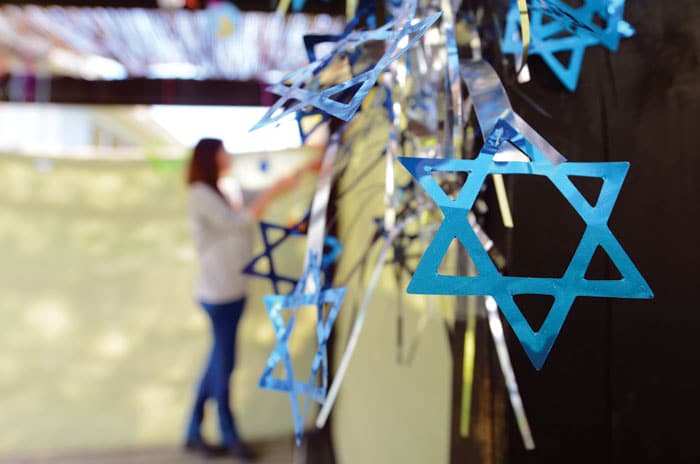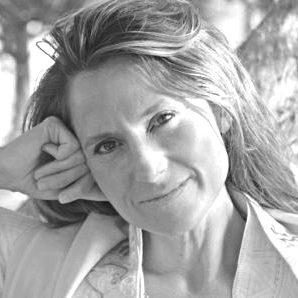 chameleonseye/Getty Images
chameleonseye/Getty Images Growing up in the Five Towns of Long Island as someone with a Jewish heritage, but without a Jewish identity, was a blend of confusion and curiosity. I witnessed a consistent litany of Jewish images such as the parade of well-dressed neighbors walking to shul every Friday night (and my feeling of being puzzled when the procession was on a Tuesday or Wednesday night), the mystery of the “women’s bath next to the middle school,” and the “huts” built every fall. Those “huts” were, for me, perhaps the greatest curiosity of all.
With autumn leaves beginning to change, and the rains beginning to fall, I would observe neighbors having meals, parties and even staying overnight in these odd huts, which I later learned were called “sukkahs.” Through years of reclaiming my own Jewish identity, more than any other ritual, the sukkah has become the highest point of Jewish symbols and rituals in my life.
Before my children’s births, every year I had my own pilgrimage: to Home Depot for Sukkot for my annual sukkah construction project. There, I cut wood, choosing slats of fine grains and smells. I’d use a hammer and nails and construct a unique design with elements inspired by sukkah projects around the world. That never changed for me, even after having given birth to my first child, when every ritual felt like a pilgrimage of bringing a bull offering to the Temple Mount. That year when Sukkot arrived, I was resolute: My daughter would sleep in the sukkah in her first year of life, and off to Home Depot we went.
Over the years, days have been spent designing, planning, hammering into the night, threading tapestries with loops for decorations … I would scent-test dried fruits alongside herbs that I would string through my sukkah …The smells intoxicated the dweller.
Over the years, days have been spent designing, planning, hammering into the night, threading tapestries with loops for decorations, tying sides tautly to ensure that my sukkah was kosher. I would scent-test dried fruits alongside herbs that I would string through my sukkah, wrapping and draping what I considered a living womb for Sukkot rebirth. The smells intoxicated the dweller, the visuals bordering on psychedelic. Each year, I would wonder, can’t I just keep it up? It is really the extra room I always wanted, but inevitably I would dismantle the masterpiece, ephemera never to exist again in quite the same form. All that would remain would be photos of Sukkot parties of years’ past filling my iPhone storage, with eight nights of meals and friends over decades, lying in a cuddle puddle of comfort and fidelity. It’s called “mo’adim l’simcha” (a time for rejoicing) for a reason.
No virtual backdrop can rival the vivid sensuality of lying on one’s back in a sukkah with nothing to do except count the stars.
Sukkot is also called “HeHag” (“The Holiday”) as there is no other observance like it. Where Rosh Hashanah can be experienced in a shul or in one’s living room, Passover in person or even on Zoom these days, Sukkot is the one Jewish observance where you can’t show up virtually. There is no way to “break out group” into the smells of the air while sitting in a sukkah, evoke the awe of looking into an endless night sky, or arouse the senses to the changing of season in a screen share. No virtual backdrop can rival the vivid sensuality of lying on one’s back in a sukkah with nothing to do except count the stars. And as I look up into mine, I see the growing collection of hanging lanterns housing tealights, tiny glowing fires that both delight and horrify me for fear of a blaze. I watch their tiny flames, like static fireflies, above my head, falling asleep with one eye open to ensure that nothing catches aflame.
Judaism is sticky, sensual and radiant and Sukkot is the perfect time to say unapologetically: The time has come to rededicate ourselves with radical rituals that intoxicate and arouse all of our senses in a post-COVID world.
A post-COVID existence is here for the long run. A blessing we can put forth is simple and imperative for the perpetuation of Jewish life: Let us pronounce this to be the year of the sukkah. While we can’t make COVID go away, we can continue to have safe gatherings outdoors. But sitting in a row of chairs or merely taking a walk together isn’t enough. Judaism is sticky, sensual and radiant and Sukkot is the perfect time to say unapologetically: The time has come to rededicate ourselves with radical rituals that intoxicate and arouse all of our senses in a post-COVID world.

The femininity of the festival should not be overlooked — its cycles of birth, death and rebirth, the vivid reds of the pomegranates cut open and staining our pillows with memories for years to come, the cornucopia of voluptuous local fruits with their come hither plumpness. Sukkot, in all of its nubile radiance, is immodest; it calls to us to look at the visions of raw, unapologetic fecundity. The images arouse us into an awakened state reserved for mystics and the modern day psychedelic journeyer, awakening us into our bodies and the evanescent truth of being: We are here now and someday we, too, will be gone.
Crawling into my sukkah, I more than invoke the presence of cultivating future generations, but do so with the presence of our shared ancestors. As we welcome in our ushpizin (the ritual invoking the presence of our bloodline all the way back to the Patriarchs and Matriarchs of the Torah into our sukkah), we are reminded that we are part of a “great chain of becoming.”
Each year, I attempt to go further back in my bloodline, with mobiles I have created through the years of my ancestors in an embodied experience of my personal story in space and time. It was in my sukkah that I began to become curious about who my grandparents’ grandparents were, and first signed up for a genealogy website. Beneath the stars of a roof festooned with s’chach, I tested my husband while dating to see if he would actually sleep in a sukkah with me all night (he passed).
Sukkot is an ideal time to bond not just with our ancestors, but with nature. As Los Angeleans, we share the same latitude as Israel and live in a similar seasonal rhythm.
Sukkot is an ideal time to bond not just with our ancestors, but with nature. As Los Angeleans, we share the same latitude as Israel and live in a similar seasonal rhythm. Our Sukkot observance holds a similar flavor palate as our ancient Israelite ancestors’ who had to set up Sukkot in the fields to gather their harvest’s bounty. We can enjoy the same ripened pomegranates and forage in our neighborhoods for fallen fruits on local trees, a sensory visitation from biting into our local produce, reminding us that Israel is as much a state of mind and imagination as it is a geographic region.
But we can’t do this on Zoom. We can’t do this through Facebook live, FaceTime, Vimeo or YouTube. The only way to do Sukkot is to get outside and do the work, and when we are done, lie on the earth and look at the stars.
Throughout COVID restrictions, we’ve tried to infuse this organic “Sukkot energy” at Open Temple by doing as many things as possible offline and outside. From Drive-in Shabbat to Bike Shabbat, Silent Beach Discos at Sunset for Havdalah to Purim in a parking lot with aerialists lit in LEDs telling the story of Esther, our commitment was to preserve the necessity (and humanity) of (safe) human contact through a time where that seemed almost impossible.
This Sukkot, we will offer a different happening every night of the holiday, with events such as Sukkot Kayak Shabbat, where a floating Sukkah will lead a fleet of kayaks down the Venice Canals. Open Temple expresses the essence of Sukkot as an intermix of ancient rituals, earth and senses into the world in which we live.
This year more than ever, Sukkot is a call to all of us to get out and live again. It’s a call to have people over, return to the sensual pleasures of redolent fruits and tactile handling of plant species. It’s the clarion call to return to the roots of community.
Sukkot, this year more than ever, is a call to all of us to get out and live again. It’s a call to have people over, return to the sensual pleasures of redolent fruits and tactile handling of plant species. It’s the clarion call to return to the roots of community. It’s a reminder from our shared ancestral history that we are a part of a multi-cultural experiment of religious significance — that rejoicing with community in a shared experience of earthly pleasure is as important as justice and mitzvot. In 5783, to build a sukkah and to dwell in it is to reenter our lives and truly reclaim a Judaism that doesn’t zoom through life.
Rabbi Lori Shapiro is the founder and artistic director of The Open Temple in Venice.





















 More news and opinions than at a Shabbat dinner, right in your inbox.
More news and opinions than at a Shabbat dinner, right in your inbox.